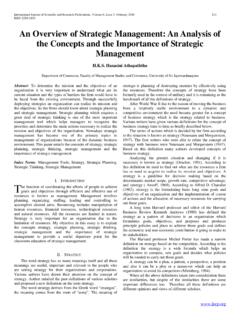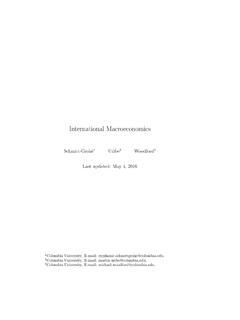Transcription of International Students and Mental Health - ed
1 - 661 - Peer-Reviewed Article ISSN: 2162-3104 Print/ ISSN: 2166-3750 Online Volume 6, Issue 3 (2016), pp. 661-677 journal of International Students International Students and Mental Health Helen Forbes-Mewett Monash University, Australia Anne-Maree Sawyer La Trobe University, Australia ABSTRACT Since the early 2000s, reports of increased rates of Mental ill Health among young people worldwide have received much attention. Several studies indicate a greater incidence of Mental Health problems among tertiary Students , compared with the general population, and higher levels of anxiety, in particular, among International Students compared with domestic Students .
2 Australia is host to many thousands of International Students of an age when Mental illnesses are most likely to surface. However, this issue has received little attention from Australian researchers. This article reports on in-depth interviews with 16 professionals working with International Students at an internationalized university. Keywords: International Students , youth, Mental Health , Health -care, integration and adjustment, higher education Since the early 2000s, Mental Health policies of western countries have prioritised the development of early intervention and treatment programs specifically targeted to young people.
3 These policy developments have been driven in part by recognition of the impacts of untreated and under-treated Mental illnesses on the growth and development of young people, their educational and occupational achievements, and ultimately their nations economic prosperity (Gore, Bloem, Patton, Patton, Ferguson, Joseph, Coffey, Sawyer, & Mathers, 2011; Hunt & Eisenberg, 2010; McGorry, 2011; Patel, Flisher, Hetrick, & McGorry, 2007). These concerns are also part of a broader context of widespread and debated claims that Mental well- journal of International Students , 6(3) 2016 - 662 - being has been declining in western countries since the Second World War ( Busfield, 2012; Collishaw, Maughan, Natarajan, & Pickles, 2004; Horwitz & Wakefield, 2007).
4 Of particular concern are reports that the greatest increase in Mental Health problems has been among young people (Collishaw et al., 2004; Fombonne, 1995). The latest Australian National Survey of Mental Health and Wellbeing shows that the highest rate of the most common Mental disorders depression, anxiety and substance misuse occurs in people aged 16 24 years (26 %), with overall prevalence decreasing with age to around one in twenty (6 %) in the oldest age group (75 85 years) (ABS, 2008). Researchers in the (Twenge, Gentile, DeWall, Ma, Lacefield, & Schurtz, 2010) and Britain (Collishaw et al.)
5 , 2010) have argued that the Mental Health of adolescents and university Students has deteriorated over recent decades, with study participants reporting significantly higher levels of emotional and stress-related problems than those of earlier cohorts. In a recent Australian study (Stallman, 2012), heads of university counselling services reported a rise in the proportion of Students presenting with serious psychological problems (p. 251) over the past five years. Other studies have shown that university Students are significantly more vulnerable to high levels of distress than non-university Students of the same age (Stallman & Shochet, 2009).
6 These claims are supported by a national survey from the US, in which 95% of directors of college counselling services reported a significant increase in severe psychological problems in their Students (Hunt & Eisenberg, 2010, p. 4). From a Western perspective, it has long been established that the peak period for onset of Mental ill- Health is between 12-25 years of age (McGorry, 2011). However, social scientists and other researchers have argued that economic, social and cultural change over the last few decades have altered the social parameters of adolescence and youth (Eckersley, 2008, 2011; Mortimer, Vuolo, Staff, Wakefield, & Xie, 2008.)
7 Sawyer, Rima, Bearinger, Blakemore, Dick, Ezeh, & Patton, 2012), contributing to higher rates of Mental illness among young people: [T]hey live in a more rapidly changing and unstable personal and social environment and are confronted by much more information about more and graver a much earlier age than previous generations (Eckersley, 2008, p. 12). Traditionally, adolescence in western countries was viewed as beginning with the physical changes of puberty and ending with the social transition into adulthood: full-time employment, marriage and parenthood.
8 The period covered by adolescence and youth has lengthened significantly journal of International Students , 6(3) 2016 - 663 - since the 1970s: the onset of puberty occurs earlier and mature social roles are entered significantly later (Sawyer et al., 2012, p. 1630). Furthermore, key social role transitions are now less distinct than in the past and less linear (Sawyer et al., 2012, p. 1630, 1632). The factors that shape pathways into adulthood are more complex and involve greater risks than in the past. Both the complexity and growing rapidity of change since the 1970s means that each new generation must deal with greater stresses and demands than the preceding one (Eckersley, 2008, p.)
9 12). These include labour market insecurities, changes in the functioning of families, increased expectations and competition in education, rapid technological advances, and the changing nature of mass and social media (Eckersley, 2011). Along with the erosion of traditional forms of social guidance and rules , these changes mean that individuals are increasingly forced to lead more flexible and fluid lives. Over twenty years ago, Giddens (1991, p. 5) described the quintessential character of late modern identity as a reflexive project of the self.
10 Ten years later, Beck and Beck-Gernsheim s (2002) metaphor of the do-it-yourself biography captured the tenor of contemporary life and identity with its promise of greater opportunities, loss of clear reference points, and focus on individualism. Biographical construction is often insecure and unstable and, under such conditions as unemployment, may become a breakdown biography (Beck & Beck-Gernsheim, 2002). Individuals may be forced to fall back on their personal resources and to view ups and downs as a matter of individual responsibility (Eckersley, 2008).














